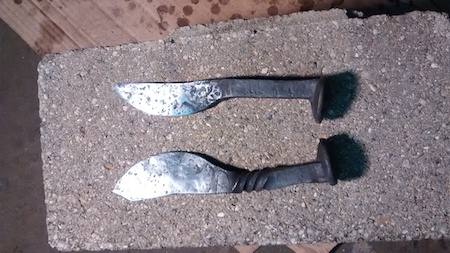

The purpose of a rail spike is to secure a section of rail track.This may produce shearing force to the area joining head to body of the spike. The process of hammering it down into a hardwood (typically oak) rail tie does involve in the application of considerable force as it is driven in *.Even at a 'low medium' carbon content, a *used* rail spike has been subjected to stress in its normal working life. (And both have sold btw.)Īnother thing to consider : New or Used material?Īll these makers stressed in their description these were HC marked spikes. Sievers (?) (shows as #19 on search)Īs far as you can tell from a photo on Etsy - those both look like very nice pieces, in terms of design, forge work and finishing. 'Typical' rail spike knife - here by Salem Straub (shows as #2 on search) Go and search Google Images : 'railroad spike knife'. I personally consider making knives from rail spikes as a kind of a beginner's trick. More important is 'how long will it *keep* that edge?'. The question should not be 'how sharp is it?' (a function of care with polishing). At that size limit, normally use of a higher carbon range is indicated.ĭo also remember that you can make a piece of paper 'sharp' enough to cut your finger. The amount of raw material on a rail spike will limit the finished cutting edge to something in the range of 4 - 6 inches. With a box cutter, which is razor sharp, but breaks with the least amount of force to it. You can hack down a tree with it, but it does not stay sharp all that long. This refers directly to what I at least call 'the Bladesmith's Dilemma' :Īs you increase * hardness * (via more carbon), you also increase * brittleness *.Ĭompare a typical machette at about 0.50 % carbon.

Any knife expected to holdĪ decent working edge should be at least the range. The second number of those specifications is 1/100 of percent carbon. The problem with rail spikes as a starting material is that the highest Heat and pound the ends into steak knives and or cheese knives? If you want that special feeling of making something with your own hands no better place to experience it than Iron Mountain Metal Craft.I have numerous rail spikes that I was hoping I could bring to you to This week we have a forge on the way (like theirs), we purchased anvils, hammers, tongs, and grinders. Since then I have talked with Andy about equipment we used and who was the supplier. Once I went outside the wife remarked, "did you know you can get another lesson to make a knife out of a horseshoe?' Needless to say I went right back inside and signed up for another lesson scheduled the next day. I left there with my knife and the feeling I made a new friend in Andy. Andy, the kind gentleman who gave the lesson was outstanding. She remarked, " you looked like kid in the candy store as you started smiling soon as you picked up the hammer." She was right I was hooked.

While I worked on the knife my wife videoed the session. I signed up for the lesson to make the railroad spike knife. The sweet girl behind the counter made my wife and I fell very welcomed. All I could think was WOW here is my chance. While on vacation we looked at many shops and found Iron Mountain Metal Craft.
Easiest way to finish a railroad spike knife tv#
I have been watching the Forged in Fire TV show and always thought I would like to try forging a knife.


 0 kommentar(er)
0 kommentar(er)
